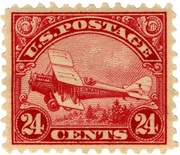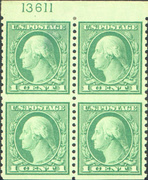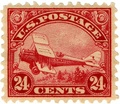
Chicago-based documentary filmmaker Mark Cwiakala grew up surrounded by stamps, yet, he never felt compelled to become a collector himself. However, eight years ago, he teamed with executive producer Jonathan Singer to go on a globetrotting journey to find out what exactly made stamps so irresistible to his grandfather and father, both well-respected philatelists. The younger Cwiakala and Singer, who head the film and commercial production company Concentrated, traveled from Monte Carlo to London to California, spending their own resources, to take their cameras inside the peculiar world of philately. Now, Cwiakala and Singer have decided that, no matter what, their documentary will make its debut in fall 2013.
“If people consider Maria Sharapova a nerd, then that’s the kind of nerd I want to be.”
The yet-to-be-completed film is called “Freaks & Errors: A Rare Collection,” which are named types of highly desirable stamps that contain errors of some sort. (The most famous U.S. error stamp is the Inverted Jenny, which features a Curtiss JN-4 biplane, printed upside down.) But of course, the title also plays with the public’s perception of stamp collectors as out-of-touch eccentrics, obsessed with an old-timey habit.
The scenes featuring interviews with 30-something singer and actress Jackie Tohn, Smithsonian curator Cheryl Ganz, and Chicago Sun-Times columnist Neil Steinberg might help break those stereotypes. But other collectors featured in the film are exactly who you’d expect—wealthy middle-aged men who are just a tad kooky. “Freaks & Errors” also promises tales of eccentric millionaires in a billion-dollar industry, as well as obsession, scandal, love, and murder. In the preview, one philatelist looks at the camera, makes his eyes big and says, “You’re going to be SHOCKED.”
We talked to Cwiakala on the phone and via email from Chicago, and he explained the motivation behind this film and its $75,000 Kickstarter campaign, running through June 14.

Top: Jackie Tohn, who appeared on “American Idol” Season 8, talks about her passion for stamps in “Freaks & Errors.” Above: “Freaks & Errors” executive producer Jonathan Singer, left, and director Mark Cwiakala show the plate of four Inverted Jennys, worth $3 million dollars. (Courtesy of Concentrated.tv)
What inspired you to make a film about stamp collectors?
As a documentary filmmaker, it interested me simply that there’s never been a feature-length documentary on stamp-collecting. My grandfather was a well-known collector for more than 70 years, and my dad is a collector and philatelic consultant. But I don’t want it to seem like I’m making this documentary to promote them or their business interests. I’m not a stamp collector myself, but I wanted to learn more about why they do it, and why it’s so special to them.

The Treskilling Yellow—a one-of-a-kind 1857 Swedish stamp that was printed in the wrong color—has been the source of scandals for 150-plus years. Worth millions, its current location is unknown. (Via GlenStephens.com)
Why didn’t you get into collecting yourself?
I don’t know why I’ve never had the impulse to collect. For some reason, I wasn’t born with the collecting gene my dad and grandfather have. That said, I seem to surround myself with people who are collectors, because I’m fascinated with how they can just focus so intently on a singular object or set of objects from a particular time period. Instead of collecting objects, I collect people and their stories on film.
What is the appeal of stamps?
Most people start collecting when they are little kids, and stamps fuel their imaginations, giving them a window into exotic places they’ve never been. The first stamps were issued in Great Britain in 1840, and at the time, the British Empire encompassed almost a quarter of the countries in the world. Quickly, you had stamps from all these places most British people had never heard of or traveled to, like Guiana, India, Hong Kong, and Rhodesia, so Europeans began collecting stamps almost as soon as they were invented. Stamps tell you a lot about the culture of a place, because countries tend to make stamps that mark big events when they happen or to honor important leaders, musicians, or artists in that country at that time. In that way, stamps are like time capsules.

Singer and Cwiakala interviewed “Chicago Sun-Times” columnist Neil Steinberg for “Freaks & Errors.” (Courtesy of Concentrated.tv)
Why did people lose interest?
Well, in most countries around the world, people haven’t lost interest at all. Stamp-collecting is growing in places that are, for lack of a better word for it, developing nations. In fact, I always say you can tell what country is about to become a super power by where stamp-collecting is growing. And right now, it’s growing in India, China, Russia, and Brazil, where people are accruing new wealth and are able to put tens of thousands of dollars into a stamp collection.
“This collector is a little reclusive, and he’s a little quirky and nerdy—so what?”
In the United States, United Kingdom, and parts of Europe, stamp-collecting has declined, and I think that has to do with technological distractions—like iPhones, Xboxes, and laptops—and the availability of information. Any topic you can come up with in the English language is covered on Wikipedia. If you want to learn about Senegal, why would you get a stamp and look it up in a stamp-collector’s book, when you can just Google “Senegal”? I mean, you’re still learning, and learning faster. It’s just less romantic than looking at a stamp and trying to imagine what it must be like in Senegal. Researching a stamp’s origin is like reading a book. And books will never go away, the same way stamp-collecting will never totally die out.

Mark Cwiakala snapped this photo of Donald Sundman, head of Mystic Stamp Company, holding his prized possession, an Inverted Jenny plate. (Courtesy of Mark Cwiakala)
If the United States Postal Service goes out of business, it won’t affect stamp-collecting; it might even make stamps even more valuable. In fact, most collectors aren’t interested in the new-issue adhesive-backed stamps. But it will affect younger kids who are attracted to new stamps because of the look and colors, rather than the history.
Why should non-collectors care about a movie on stamp-collecting?
Globally, the stamp trade is a billion-dollar business, so if anything, the money involved usually blows people away. In the past 30 years, stamp-collecting, at a certain level, has become very expensive. You used to be able to by the better items for a lot less than you can now. Stamp values blew up in the 1970s, partly due to collectors and speculators “investing” in stamps to stave off U.S. and global inflation, the poor stock market, and low gold prices. These values never retreated, so a $250 stamp that ballooned to $2,500 stayed there. It’s made it difficult for the modest collector to start a sophisticated collection. In the end, though, the value of a stamp is just the willingness of someone to pay a certain amount for it.

The filmmakers visited Monte Carlo to uncover the mysteries of philately. (Courtesy of Concentrated.tv)
Often kids start out as country collectors, collecting the stamps from their own countries. Then they move to more specific interests: sports, authors, politicians, other countries, or maybe ducks. As they get older and accumulate more wealth, they will go for the more expensive stamps they’ve always wanted. I’ve heard from collectors that it keeps a lot of people going as they get older, that they almost refuse to die until they’ve found that one stamp, the one piece that could complete their collection.
A lot of people I talk to who, at first, say they have no interest in stamp-collecting, when they think about it more, usually come back with memories of a grandfather or an uncle who was a stamp collector. When they realize that, it gives them a personal connection to the film, as an opportunity to find out what drew their family to it.
What are some of these scandals, mysteries, and murders you mention?

“Freaks & Errors” hunts down the notorious Penny Magneta stamp, which could be worth $5 million. (Via The Stamp Collecting Round-Up)
If we sat down and I just told you the story of the Penny Magenta, a one-cent British Guiana stamp from the 1800s, you’d be hooked. The history of this stamp, even today, can rival any mystery story or noir thriller. In 1856, a shipment of stamps had failed to arrive at the British colony of Guiana, and the frustrated local postmaster, E.T.E. Dalton, commissioned a local printer to make stamps as an emergency measure. The postmaster, however, didn’t like the design, and restricted their use, requiring post office clerks to sign all stamps.
Only one of these stamps is now known to exist, and it’s been owned by some of the most eccentric people in history. Currently, it’s whereabouts is known to a select few. Its owner was the late John E. DuPont, who is infamously known for killing a wrestler staying at his estate in 1997. DuPont died in a mental facility in 2010, and the future of the Magenta is once again up in the air. If it sells, it could go for upwards of $5 million. No one has seen it in a while. It’s really not much to look at, it’s dark and smudgy. At this point, it could be completely unrecognizable, but that wouldn’t change the value.
Does the film do anything to break the stereotypes about stamp collectors?

Stamp collectors often have floor-to-ceiling stacks of stamp albums. This collector’s Los Angeles office shows how chaotic it can get. (Courtesy of Concentrated.tv)
Not really. It’s more like, so this collector is a little reclusive, so what? He’s a little quirky and nerdy, so what? Who can honestly define the word “nerd” without reflecting a little bit about themselves? Most stamp collectors are extremely intelligent and completely fascinating.
“The history of this stamp, even today, can rival any mystery story, or noir thriller.”
Maria Sharapova came out as an avid stamp collector in 2009, and she said she’s regretted it ever since. People said, “How can a tennis player be a stamp collector? How can someone so beautiful be a stamp collector?” If people consider Maria Sharapova a nerd, then that’s the kind of nerd I want to be.
And there are a lot of other famous collectors that you would never have guessed: Ron Wood of the Rolling Stones; the owner of the Dallas Mavericks, Mark Cuban (who apparently funded part of his college through selling stamps); and the former President of France, Nicholas Sarkozy. We’re hoping that we can get one or more of the more high-profile collectors to agree to an interview, as I think it would say a lot about the hobby.
You’re asking for $75,000 on Kickstarter? What happens if you don’t hit that?

A close-up of an Inverted Jenny, which occurred in 1918, when the printer failed to noticed the Curtiss JN-4 biplane, nicknamed “Jenny,” was flying upside down. (Courtesy of Concentrated.tv)
We are going to finish this film regardless. We will do whatever it takes. It’s got so much appeal to us personally, and everyone we talk to is excited. There are other grant options that we are exploring, but I think the Kickstarter community adds just that, a community, which creates ambassadors for the film.
To come up with that number, we took an average of film-finishing costs based on our commercial production experience and what we learned from other filmmakers who have completed films themselves. We’ve had a few funding offers from some larger stamp firms, but we want to keep the film pure. We don’t want any specific business to benefit from it; we’re hoping to benefit the hobby as a whole. If you take money from a company, they usually send somebody to say, ‘You need more of this, you need less of this, you need to mention this’. We didn’t want that; we want it to grow organically.
(More information on stamp-collecting from Cwiakala’s family can be found at Cwiakala.com.)

 How Science Made Your Dino Toys Extinct
How Science Made Your Dino Toys Extinct
 Cheryl Ganz of the National Postal Museum on Inverted Jennys and Burning Zeppelins
Cheryl Ganz of the National Postal Museum on Inverted Jennys and Burning Zeppelins How Science Made Your Dino Toys Extinct
How Science Made Your Dino Toys Extinct John Hotchner Exposes Philatelic Errors, Freaks, and Oddities
John Hotchner Exposes Philatelic Errors, Freaks, and Oddities Errors Freaks and OdditiesErrors, freaks, and oddities sound like judgmental characterizations, but f…
Errors Freaks and OdditiesErrors, freaks, and oddities sound like judgmental characterizations, but f… StampsThe world’s first adhesive postage stamp was the Penny Black, printed for t…
StampsThe world’s first adhesive postage stamp was the Penny Black, printed for t… Mari Tepper: Laying it on the Line
Mari Tepper: Laying it on the Line Nice Ice: Valerie Hammond on the Genteel Charm of Vintage Canadian Costume Jewelry
Nice Ice: Valerie Hammond on the Genteel Charm of Vintage Canadian Costume Jewelry How Jim Heimann Got Crazy for California Architecture
How Jim Heimann Got Crazy for California Architecture Modernist Man: Jock Peters May Be the Most Influential Architect You've Never Heard Of
Modernist Man: Jock Peters May Be the Most Influential Architect You've Never Heard Of Meet Cute: Were Kokeshi Dolls the Models for Hello Kitty, Pokemon, and Be@rbrick?
Meet Cute: Were Kokeshi Dolls the Models for Hello Kitty, Pokemon, and Be@rbrick? When the King of Comedy Posters Set His Surreal Sights on the World of Rock 'n' Roll
When the King of Comedy Posters Set His Surreal Sights on the World of Rock 'n' Roll How One Artist Makes New Art From Old Coloring Books and Found Photos
How One Artist Makes New Art From Old Coloring Books and Found Photos Say Cheese! How Bad Photography Has Changed Our Definition of Good Pictures
Say Cheese! How Bad Photography Has Changed Our Definition of Good Pictures Middle Earthenware: One Family's Quest to Reclaim Its Place in British Pottery History
Middle Earthenware: One Family's Quest to Reclaim Its Place in British Pottery History Fancy Fowl: How an Evil Sea Captain and a Beloved Queen Made the World Crave KFC
Fancy Fowl: How an Evil Sea Captain and a Beloved Queen Made the World Crave KFC
I love the movie of Richard Pryor a BREWSTER MIllionaire when he bought a Jenny Stamp for almost a Million Dollars and Mailed it to those 2 Old man. Lol, Freak & Error stories that I have on my possesion as 11c, 2 top Great Presidents voted by Presidential Historian Society among 41 Presidents served in Oval Office. Lincoln ( Penny/cent) Roosevelt (dime/10 cents) Accidentally minted in US Mint. Certified & Graded by the famous Inventor of slabbing coins/cards & professional experts in Numismatist World. My double denomination 11c, graded as MINT No Numerical Number assigned due this coin is the most major dramatic in all error as a KING of errors as 1995 Penny On Dime. You can find all the stories and vids to my channel in you tube. pennyondime95 < My handle or photobucket as edwinrd117. The Past,The Present & the Future a freak /weirds images on my double denomination 11c. great stories behind it… How I got it and well protected againts shark & vulture in Numismatist World. -HOBBY of a KING!
Check this one out on my you tube..
http://www.youtube.com/watch?v=lzDp4Fd-AI8
Here’s another one in Photobucket..
http://s817.photobucket.com/user/edwinrd117/story/11905
Interesting clip about the movie on stamps. I would hope that the movie makes it clear that the hobby is for all people to enjoy, not just the rich. People of all different financial levels collect stamps. The topics on the stamps themselves can vary from soup to nuts, everything is out there. Then, there are those collectors who spread out into postal history who are checking all of those covers for their postmarks etc. In short, there are so many levels and facets to the hobby so that maybe just one movie would not be enough room.
Happy collecting.